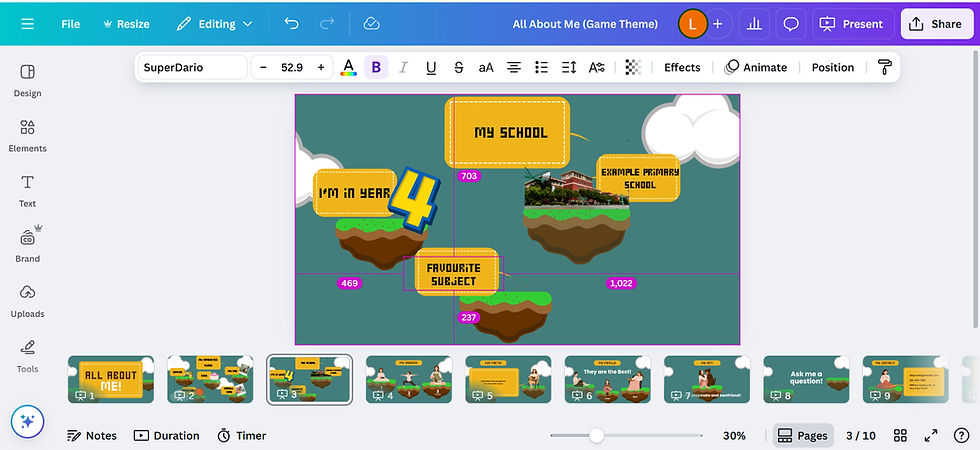Using Graphic Design Software to Empower Life Story Work
- Louis Moore

- Aug 11
- 4 min read
Using graphic design software can initially feel daunting. As a social worker, our digital skills rarely go beyond Microsoft programs (Word or PowerPoint) and our organisation’s case management systems. However, graphic design software plays an important role in creating smart, visually engaging life story books that reflect a young person's experiences and identity.
This article explores what graphic design software is, why and how practitioners can use it, and reviews some example tools for life story work.
What is Graphic Design Software?
Graphic design software refers to digital programs that are used to create and edit visual content. These tools have many purposes, from producing 3D models for architecture to digital illustrations or photo editing. For life story work, graphic design software can be used to assemble text, photos and illustrations into a cohesive, visually engaging book.
The design programs most suited to life story work are those used for publishing books, magazines or presentations. Programs like Canva and Adobe InDesign allow users to design books using images, text, and graphic elements. They offer young people a choice of engaging styles and formats, while providing time-saving tools for practitioners.

Why Use Graphic Design Software for Life Story Books
Technology is only one of many creative tools used in life story work. Direct work with children remains a core part of the therapeutic process. This involves children and their social workers using various creative methods, such as drawing, craft, play and conversation, to navigate their story.
Assembling a clear and structured life story book is another essential aspect that brings the creative work together. Graphic design tools support this by enabling practitioners to visually present the child’s narrative and include their creations. The final product should be a professional, engaging book that reflects the young person's identity and journey. Children can take ownership of their book, and a digital copy can also be stored in their case records.
Life story books should look as important as the stories they hold. While Microsoft Word or PowerPoint are commonly used, they often result in a generic appearance that lacks creativity. Graphic design software, by contrast, can transform the book’s visual quality without requiring extensive technical knowledge.
How Can Social Workers Use Graphic Design Software?
Most graphic design tools can be accessed online or downloaded to your computer. Some offer free versions with limited features, while others require paid subscriptions. Many platforms provide built-in tutorials, although more advanced tools may require additional learning via YouTube or by asking a tech-savvy colleague.
How Have We Reviewed Graphic Design Programs?
We’ve selected four examples of graphic design software that offer advantages for life story work. We’ve tested and reviewed them in terms of their key features, pros and cons, required skill level and cost.
A key consideration is usability. Social workers need tools that are easy to learn, time-efficient, and supportive of social work values. The software should enhance young people's participation and creativity without making the design process overwhelming or overly time-consuming.
Importantly, any design tool used must uphold safeguarding principles and data protection standards. Even if young people are not using the software themselves, the content must remain age-appropriate and securely stored.
For practitioners already comfortable with design, more sophisticated programs might be worth exploring. But for many of us, intuitive and accessible tools can still produce high-quality, meaningful results.
Design Programs Reviewed for Life Story Work
Canva
Key Features: Drag-and-drop design, wide selection of fonts, graphics, and templates for various formats.
Strengths: Easy to learn; visually engaging; includes user-generated templates adaptable for life story books.
Weaknesses: Limited tools for compiling longer books; more suited to presentations.
Skill Level: Low to Medium
Cost: Free version available; Premium £13/month or £100/year
Adobe InDesign
Key Features: Professional publishing software; integrates with other Adobe tools.
Strengths: Highly customisable; ideal for precise layout and print preparation.
Weaknesses: Complex and potentially overwhelming; limited life story-specific templates.
Skill Level: Medium to High
Cost: Free 7-day trial; then £21.98/month or £262.51/year (some templates cost extra)

Adobe Express
Key Features: Simple design tool with drag-and-drop functionality; library of templates and content.
Strengths: Fast, easy-to-use; visually appealing; integrates with Adobe Suite.
Weaknesses: Limited templates suitable for full life story books.
Skill Level: Low to Medium
Cost: Free version; Premium £9.98/month or £99.99/year

BookWright
Key Features: Designed for publishing books and magazines; integrates with Blurb for printing.
Strengths: Professional layout tools; built-in print option; good for data security.
Weaknesses: Limited design templates; visually plain, may not appeal to young people.
Skill Level: Medium
Cost: Free to use; Printing costs approx. £28–£35 for a standard hardback
Which Tool Has Own My Story Chosen?
At Own My Story, we look for design tools that combine simplicity with creative flexibility. We want young people to have a diverse range of design features, fonts and themes to personalise their books.
After trialling several platforms, Canva stood out as the most applicable tool for our needs. Its range of adaptable templates, including 'All About Me' designs, supports both young people and practitioners in creating personalised, visually engaging books. Canva’s ease of use also makes it suitable for other types of creative direct work.
While some advanced programs may offer more features, they often demand more time and skill than most social workers can realistically commit. Life story work involves time-intensive tasks such as direct work, information gathering, and coordination. The design process should support, not overshadow, our main objectives in presenting a young person’s identity, experiences and voice.
As our service grows, we may adopt more advanced tools to build custom templates and provide greater personalisation. Our long-term vision includes collaborating with graphic designers to expand our creative capacity.
For now, Canva offers a powerful, accessible solution for creating meaningful, high-quality life story books that empower both young people and the practitioners who support them.


Comments